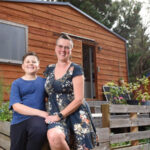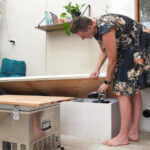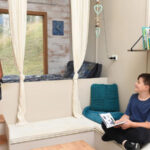Over 60s women main driver for lift in small home sales

LONDON: Over 60s women are the main driver behind a lift in small home sales.
The number of people living in tiny homes has surged as cost-of-living pressures and soaring regional property prices driving demand beyond the pandemic.
Houses as small as only 10sq m are attracting buyers seeking minimalist lifestyles and being touted as part of the solution to the housing affordability crisis.
House prices have risen an average of 22 per cent over the past two years through COVID in Melbourne and 36 per cent in regional Victoria, PropTrack data shows.
Australian Tiny Homes Association (ATHA) president Janine Strachan said the property type was a “housing solution for a diverse range of people” — particularly those constrained by affordability, including retirees struggling with rising house and land costs.
“It puts more housing and rentals on the market, helping people stay in communities they love but can’t afford anymore,” she said.
The increasing demand for tiny homes is demonstrated across the board, with the ATHA hosting more than 200 builder, business and individual members.
Ms Strachan also highlighted the significant number of people in tiny home Facebook groups across Australia, such as ‘Tiny Home Communities’ which has more than 49,000 members, or ‘Tiny Homes Australia’ with more than 14,000.
The latter started in March 2017 with only two members, and continues to grow each day. Group admin Donna Birch said it was currently gaining about 110 new Australian members each week.
About 12,000 people also flocked to the Melbourne Tiny Homes Expo in March, according to the organiser, Phae Barrett, which showcased a range of tiny builds including modulars, container homes, cabins, granny flats, domes, and more
Ms Barrett estimated that more than 600 tiny homes were being sold per month, both to Air BnB operators and people wishing to live in them permanently.
She also said that the “cost of buying them had increased some 50 per cent in the same time frame,” with current prices ranging from $70,000-$150,000.
“A cheap one is around $70,000, but something with a bit of luxury that has all the bells and whistles is around $130,000. You could also build your own for under $150,000,” she said.
Single mother Briony Jenkins has been living in her tiny home in Mt Egerton since 2018, saving her and her two children from financial instability.
Ms Jenkins was struggling to provide for the kids after her divorce in 2016, going between various rentals and living paycheck-to-paycheck.
“It makes me teary thinking now about the financial anxiety I had before, compared to now,” she said.
“I didn’t feel like I had a lot of other options. But I don’t stress anymore. I’m not in a 9-5 job, and we still eat out whenever we want and do the things we love. We’re better off both financially and emotionally.”
As the 3496sq m block was farming zoned, Ms Jenkins was able to buy it cheaply. While the land came with the tiny house, she has since built a second one for her daughter, now 16 years old, who needed her own space. Ms Jenkins and her ten year old son co-sleep in a queen bed.
Describing herself as a “reformed hoarder”, she sold the majority of her possessions prior to purchasing the Mt Egerton block.
Now, the mother-of-two stores her remaining items in the property’s small shed. She also maximises the tiny home’s space, storing clothes and shoes in tubs under built-in modular couches with liftable seats.
“I love a capsule wardrobe, so I cycle through wearing the same things. The one or two nice dresses I have are hung on the back of the bathroom door.”
The family stays warm in winter through a diesel heater, which Ms Jenkins said are usually found in caravans and trucks.
But she admits that living tiny does come with it’s struggles.
“We’re completely off-grid, so there’s no water, power or sewerage,” she said.
“We run internet off a hotspot on my phone. We have solar power but it’s very simple. I’ve built three generators so far.”
She said rubbish disposal was also difficult, and the composting toilet “didn’t work well”.
“I’ve considered going back to regular dwelling occasionally when things don’t work,” Ms Jenkins said.
“But I think of all the financial stress and the cleaning, and realise how happy I am here.”
“It sort of feels like we’re playing pretend,” she laughed. “It puts a bit of novelty back into adult life.”
Ms Jenkins now runs a website called parkmytinyhouse.com.au, which connects property owners with those looking for a place to park their tiny house on wheels.
- Briony Jenkins and her son Ryder in their Mt Egerton tiny home
- Maximising space by storing things under liftable, modular couches
- Briony Jenkins and her son Ryder in their Mt Egerton tiny home









